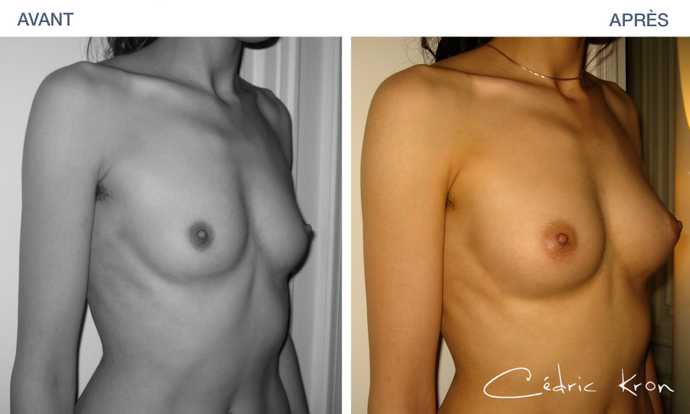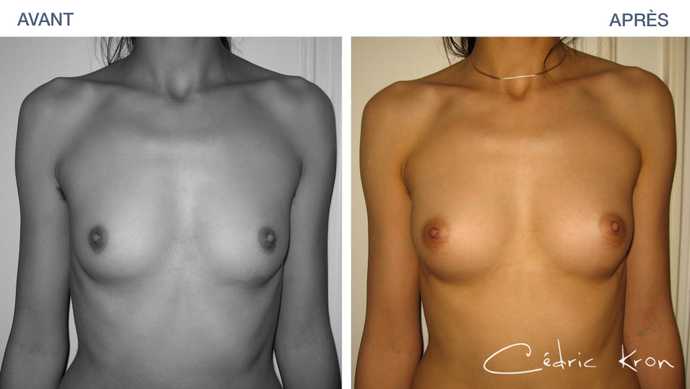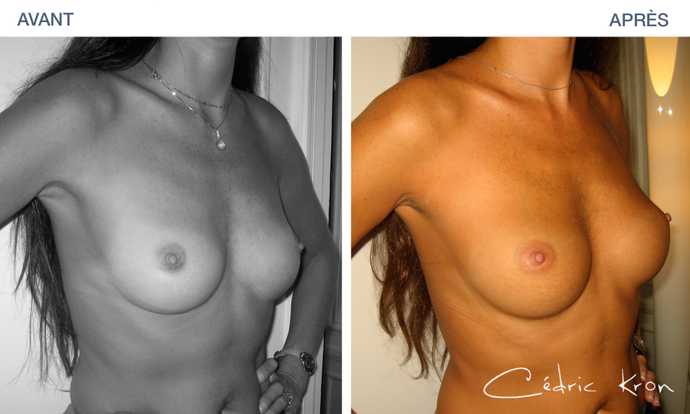A breast lipofilling is an aesthetic surgery procedure that consists in performing a trandsfer of fat cells of the patient's own body to fill or increase a lack of volume in the breasts (breast hypotrophy). A breast lipofilling is a technique of cosmetic surgery of the breasts which allows to obtain a lasting and natural result with almost invisible scars.
In brief: breast lipofilling
- Result: Natural after 1 month - Final result between 6 months and 1 year.
- Anesthesia: General anesthesia
- Pain: Between 2 and 3/10
- Scars: Small (3-4 mm in the groin fold and the gluteal fold for liposuction, in the sub-mammary fold for breast lipofilling).
- Hospitalization: Day Hospitalization
- Recovery: About 5 days.
- Resuming sport activities: Progressive from 2-3 weeks according to type of sports
- Duration of procedure: 90 minutes
The objective of a breast lipofilling
Breast lipofilling is indicated in women with breast hypotrophy: their breasts are insufficiently developed in relation to their morphology. This technique of cosmetic surgery can correct a defect in the volume and shape of the breasts that may exist since puberty or have been caused by significant weight loss or a pregnancy...
The objective of the procedure is to obtain a harmonious breast shape, proportioned to the body of the patient and corresponding to her desire.
This technique can complement a breast augmentation with implants, both for aesthetic reasons or for a reconstruction after breast cancer.
Advantages of this technique
Breast augmentation using the lipofilling technique presents three advantages:
- The result is durable and natural because caused by the patient's own cells
- The scars involved in the procedure are almost invisible (2 mm below the breast or on the side of the breast)
- It allows to some extent to correct a moderate breast ptosis (sagging breasts), often associated with hypotrophy.
In case of large mammary ptosis, breast rejuvenation surgery involving a different technique is usually indicated in isolation or in combination.
Lipofilling as part of a breast reconstruction
A lipofilling is also indicated in cases of breast reconstruction after total mastectomy. This procedure helps to rebuild breast volume and improve tissue quality. Since a recurrence is always possible, the surgeon must always perform a pre-operative clinical examination (examination of the cellular tissue, ultrasonography of the chest wall, sometimes a biopsy).
In the case of a partial breast reconstruction after tumorectomy and considering the risk of recurrence, reconstruction by lipofilling of the breasts can only be performed at least 3 years after of clinical and radiological monitoring.
SoFCPRE Notice:
The SoFCPRE meeting in National Congress on Wednesday, November 24, 2011 addressed the issue of breast fat transfer (breast lipofilling). The technique of fat transfer in the breast, is currently a recognized technique of high efficiency.
To be practiced according to the proven data of science, it must be performed in a surgical environment, by a plastic surgeon trained specifically for this technique. The practice of this technique outside the previously defined surgical setting is considered dangerous for patients.

The principle of breast augmentation by fat injection
A lipofilling is a surgical technique of reinjection of fat cells, that is to say that it uses the patient's own fat cells to reshape parts of the body.
Collection of fat cells
The surgeon begins the procedure by identifying the areas where the fat will be collected and the sites of reinjections.
Then, a fat tissue sample is collected by micro-incision using a fine suction cannula or during a conventional liposuction. The fat cells are taken from an area of the discrete body where there is a reserve, or even an excess of fat cells (generally, in the abdomen, hips, knees, inner thighs, buttock)
The collected fat cells are then subjected to a sterile centrifugation for a few minutes so as to separate the cells that will be injected (intact fat cells) from the elements that must not be injected (fat cells destroyed by the sample, non-fat cells such as than blood cells).
Injection of fat cells into the breasts
The reinjection of fat (lipofilling) is performed using micro-cannulas allowing incisions of the order of 1-2 mm.
The injections are performed in different angles and in multiple directions so as to increase the contact area between the grafted cells and the recipient tissues (feeders), allowing a "good grip" of the injection.
The duration of the breast lipofilling may vary depending on the amount of fat to be injected and the number of areas treated. The procedure length usually ranges from 30 minutes to two hours.
Follow-up after a breast lipofilling
Depending on the patient and the procedure performed, simple local anesthesia or general anesthesia may be considered.
The procedure is usually performed with a day hospitalization (without overnight stay in the hospital).
Postoperative pain is very moderate in the majority of cases.
It is normal that an edema appears within 48 hours of surgery. It will be completely disappeared within 5 to 15 days following the procedure.
Bruising appears in the areas of greasy sampling and reinjection. These bruising disappear within 5 to 21 days. It is a less cumbersome procedure than a breast augmentation with implants. It is possible to resume normal activity 2 to 4 days after the procedure.
Result of a lipofilling of the breasts
When the result can be seen?
The result of a lipofilling of the breasts can be appreciated once the edema and bruises resorbed. In the case of a lipofilling of the breasts, the edema is resorbed in about 3 weeks. The result can be considered definitive after 3 to 6 months.
A lasting result
A breast lipofilling allows a lasting result unlike the technique of cosmetic breast augmentation medicine by Macrolane (which is no longer practiced by Dr. Kron). It is indeed a true transplantation of the patient's own cells: the grafted cells remain alive as long as the tissues in which they were grafted.
There may be a 10 to 30% loss in the amount of fat re-injected. The surgeon takes this phenomenon into account in order to evaluate the quantity of cells to be grafted. In some (rare) cases, it is possible that a second breast lipofilling procedures is needed to obtain the desired shape.
Scars after a lipofilling?
Compared to a breast augmentation by prosthesis, a breast lipofilling causes very little risk of visible scars because of the fineness of the cannula used for the removal and transplantation of fat cells.
The result is also natural insofar as the reinjected fat corresponds to the normal tissues of the body and the breast which is composed in part and that the technique allows to perform a real "sculpture" of the curve of the breast.
Smoking increases the risk of surgical complications of any surgery. Stopping smoking 6-8 weeks before the procedure eliminates this additional risk. If you smoke, talk to your doctor, surgeon, and anesthesiologist, or call Tobacco-Info-Service at 3989 to help reduce risk and put the odds on your side.
Before-after: breast augmentation by lipofilling

